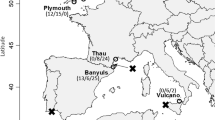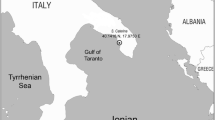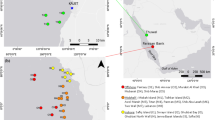Abstract
Loliginid and sepiolid squid light organs are known to host a variety of bacterial species from the family Vibrionaceae, yet little is known about the species diversity and characteristics among different host squids. Here we present a broad-ranging molecular and physiological analysis of the bacteria colonizing light organs in loliginid and sepiolid squids from various field locations of the Indo-West Pacific (Australia and Thailand). Our PCR-RFLP analysis, physiological characterization, carbon utilization profiling, and electron microscopy data indicate that loliginid squid in the Indo-West Pacific carry a consortium of bacterial species from the families Vibrionaceae and Photobacteriaceae. This research also confirms our previous report of the presence of Vibrio harveyi as a member of the bacterial population colonizing light organs in loliginid squid. pyrH sequence data were used to confirm isolate identity, and indicates that Vibrio and Photobacterium comprise most of the light organ colonizers of squids from Australia, confirming previous reports for Australian loliginid and sepiolid squids. In addition, combined phylogenetic analysis of PCR-RFLP and 16S rDNA data from Australian and Thai isolates associated both Photobacterium and Vibrio clades with both loliginid and sepiolid strains, providing support that geographical origin does not correlate with their relatedness. These results indicate that both loliginid and sepiolid squids demonstrate symbiont specificity (Vibrionaceae), but their distribution is more likely due to environmental factors that are present during the infection process. This study adds significantly to the growing evidence for complex and dynamic associations in nature and highlights the importance of exploring symbiotic relationships in which non-virulent strains of pathogenic Vibrio species could establish associations with marine invertebrates.




Similar content being viewed by others
References
Nishiguchi MK, Nair VS (2003) Evolution of symbioses in the Vibrionaceae: a combined approach using molecules and physiology. Int J Syst Evol Micr 53:2019–2026
Farmer JJ III, Janda JM, Brenner FW, Cameron DN, Birkhead KM (2005) Genus I. Vibrio Pacini 1854, 411AL. In: Brenner DJ, Krieg NR, Staley JT, Garrity GM (eds) Bergey’s manual of systematic bacteriology, vol 2. Springer, New York, pp 494–546
Dikow RB (2010) Systematic relationships within the Vibrionaceae (Bacteria: Gammaproteobacteria): steps toward a phylogenetic taxonomy. Cladistics 27:9–28
Thompson FL, Hoste B, Vandemeulebroecke K, Swings J (2001) Genomic diversity amongst Vibrio isolates from different sources determined by fluorescent amplified fragment length polymorphism. Syst Appl Microbiol 24:520–538
Jones BW, Nishiguchi MK (2004) Counterillumination in the bobtail squid, Euprymna scolopes Berry (Mollusca: Cephalopoda). Mar Biol 144:1151–1155
Dunlap PV, McFall-Ngai MJ (1987) Initiation and control of the bioluminescent symbiosis between Photobacterium leiognathi and the leiognathid fishes. In: Lee, JJ, Frederick, JF (eds.) Proceedings of the New York Academy of Sciences Symposium on Endosymbiosis, pp. 269–283
Fidopiastis PM, Boletzky Sv, Ruby EG (1998) A new niche for Vibrio logei, the predominant light organ symbiont of squids in the genus Sepiola. J Bacteriol 180:59–64
Colwell RR, Huq A (1994) Vibrios in the environment: viable but nonculturable Vibrio cholerae. In: Wachsmuth IK, Blake PA, Olsvik O (eds) Vibrio cholerae and cholera: molecular and global perspectives. American Society of Microbiology Press, Washington, D.C., pp 117–133
Yumoto II, Iwata H, Sawabe T, Ueno K, Ichise N, Matsuyama H, Okuyama H, Kawasaki K (1999) Characterization of a facultatively psychrophilic bacterium, Vibrio rumoiensis sp. nov., that exhibits high catalase activity. Appl Environ Microbiol 65:67–72
Ruby EG, Morin JG (1979) Luminous enteric bacteria of marine fishes: a study of their distribution, densities, and dispersion. Appl Environ Microbiol 38:406–411
Ruby EG, Nealson KH (1976) Symbiotic associations of Photobacterium fischeri with the marine luminous fish Monocentris japonica: a model of symbiosis based on bacterial studies. Biol Bull 151:574–586
Guerrero-Ferreira RC, Nishiguchi MK (2007) Biodiversity among luminescent symbionts from squid of the genera Uroteuthis, Loliolus and Euprymna (Mollusca: Cephalopoda). Cladistics 23:497–506
Stabili L, Gravili C, Piraino S, Boero F, Alifano P (2006) Vibrio harveyi associated with Aglaophenia octodonta (Hydrozoa, Cnidaria). Microb Ecol 52:603–608
Foster JS, Boletzky Sv, McFall-Ngai MJ (2002) A comparison of the light organ development of Sepiola robusta Naef and Euprymna scolopes Berry (Cephalopoda: Sepiolidae). Bull Mar Sci 70:141–153
Dalsgaard A, Serichantalergs O, Forslund A, Lin W, Mekalanos J, Mintz E, Shimida T, Wells AJG (2001) Clinical and environmental isolates of Vibrio cholerae serogroup O141 carry the CTX phage and the genes encoding the toxin-coregulated pili. J Clin Microbiol 39:4086–4092
Huq A, Small EB, West PA, Huq MI, Rahman R, Colwell RR (1983) Ecological relationships between Vibrio cholerae and planktonic crustacean copepods. Appl Environ Microbiol 45:275–283
DePaola A, Ulaszek J, Kaysner CA, Tenge BJ, Nordstrom JL, Wells J, Puhr N, Gendel SM (2003) Molecular, serological, and virulence characteristics of Vibrio parahaemolyticus isolated from environmental, food, and clinical sources in North America and Asia. Appl Environ Microbiol 69:3999–4005
Alcaide E, Amaro C, Todoli R, Oltra R (1999) Isolation and characterization of Vibrio parahaemolyticus causing infection in Iberian toothcarp Aphanius iberus. Dis Aquat Organ 35:77–80
Alcaide E, Gil-Sanz C, Sanjuan E, Esteve D, Amaro C, Silveira L (2001) Vibrio harveyi causes disease in seahorse, Hippocampus sp. J Fish Dis 24:311–313
Alcaide E, Sanjuan E, del Ganaa F, Garcia-Gomez A (2000) Susceptibility of Amberjack (Seriola dumerili) to bacterial fish pathogens. Bull Eur Ass Fish Pathol 20:153–156
Banin E, Israely T, Kushmaro A, Loya Y, Orr E, Rosenberg E (2000) Penetration of the coral-bleaching bacterium Vibrio shiloi into Oculina patagonica. Appl Environ Microbiol 66:3031–3036
Ben-Haim Y, Zicherman-Keren M, Rosenberg E (2003) Temperature-regulated bleaching and lysis of the coral Pocillopora damicornis by the novel pathogen Vibrio coralliilyticus. Appl Environ Microbiol 69:4236–4242
Stelma GN Jr, Reyes AL, Peeler JT, Johnson CH, Spaulding PL (1992) Virulence characteristics of clinical and environmental isolates of Vibrio vulnificus. Appl Envrion Microbiol 52:2776–2782
Aznar R, Ludwig W, Amann RI, Schleifer KH (1994) Sequence determination of rRNA genes of pathogenic Vibrio species and whole-cell identification of Vibrio vulnificus with rRNA-targeted oligonucleotide probes. Int J Syst Bacteriol 44:330–337
Owens L, Busico-Salcedo N (2006) Vibrio harveyi: pretty problems in paradise. In: Thompson FL (ed) The biology of vibrios. ASM Press, Washington, D.C., pp 266–280
Vidgen M, Carson J, Higgins M, Owens L (2006) Changes to the phenotypic profile of Vibrio harveyi when infected with the Vibrio harveyi myovirus-like (VHML) bacteriophage. J Appl Microbiol 100:481–487
Dunlap PV, Davis KM, Tomiyama S, Fujino M, Fukui A (2008) Developmental and microbiological analysis of the inception of bioluminescent symbiosis in the marine fish Nuchequula nuchalis (Perciformes: Leiognathidae). Appl Environ Microbiol 74:7471–7481
Liu WT, Marsh TL, Cheng H, Forney LJ (1997) Characterization of microbial diversity by determining terminal restriction fragment length polymorphisms of genes encoding 16S rRNA. Appl Environ Microbiol 63:4516–4522
Ley RE, Lozupone CA, Hamady M, Knight R, Gordon JI (2008) Worlds within worlds: evolution of the vertebrate gut microbiota. Nat Rev Microbiol 6:776–788
Ward DM, Weller R, Bateson MM (1990) 16S rRNA sequences reveal numerous uncultured microorganisms in a natural community. Nature 345:63
Guerrero-Ferreira RC, Nishiguchi MK (2009) Ultrastructure of light organs of loliginid squids and their bacterial symbionts: a novel system for the study of marine symbioses. Vie et Milieu 59:307–313
Jamann S, Fernandez MP, Normand P (1993) Typing method for N2-fixing bacteria based on PCR-RFLP-application to the characterization of Frankia strains. Mol Ecol 2:17–26
Urakawa H, Kita-Tsukamoto K, Ohwada K (1997) 16S rDNA genotyping using PCR/RFLP (restriction fragment length polymorphism) analysis among the family Vibrionaceae. FEMS Microbiol Lett 152:125–132
Urakawa H, Kita-Tsukamoto K, Ohwada K (1998) A new approach to separate the genus Photobacterium from Vibrio with RFLP patterns by HhaI digestion of PCR-amplified 16S rDNA. Curr Microbiol 36:171–174
Urakawa H, Kita-Tsukamoto K, Ohwada K (1999) 16S rDNA restriction fragment length polymorphism analysis of psychrotrophic vibrios from Japanese coastal water. Can J Microbiol 45:1001–1007
Urakawa H, Kita-Tsukamoto K, Ohwada K (1999) Microbial diversity in marine sediments from Sagami Bay and Tokyo Bay, Japan, as determined by 16S rRNA gene analysis. Microbiology 145(Pt 11):3305–3315
Yoshimura S, Yoshimura A, Saito A, Kishmoto N, Kawase M, Yano M, Nakagahra M, Ogawa T, Iwata N (1992) RFLP analysis of introgressed chromosomal segments in three near-isogenic lines of rice for bacterial blight resistance genes, Xa-1, Xa-3 and Xa-4. Jpn J Genet 67:29–37
Marhual NP, Das BK (2009) Use of random amplified polymorphic DNA and restriction fragment length polymorphism for typing of Vibrio alginolyticus isolated from black tiger shrimp Penaeus monodon. J Pure Appl Microbiol 3:75–82
Nishiguchi MK, Lopez JE, Boletzky Sv (2004) Enlightenment of old ideas from new investigations: more questions regarding the evolution of bacteriogenic light organs in squids. Evol Dev 6:41–49
Wheeler WC (1996) Optimization alignment: the end of multiple sequence alignment in phylogenetics? Cladistics 12:1–9
Wheeler WC (1998) Alignment characters, dynamic programming and heuristic solutions. In: DeSalle R, Schierwater B (eds) Molecular approaches to ecology and evolution, vol 1. Birkhauser Verlag, Basel, pp 243–251
Wheeler WC, Gladstein D, DeLaet J (2002) POY v. 3.0
Wheeler WC (1995) Sequence alignment, parameter sensitivity, and the phylogenetic analysis of molecular data. Syst Biol 44:321–331
Alsina M, Blanch AR (1994) Improvement and update of a set of keys for biochemical identification of Vibrio species. J Appl Bacteriol 77:719–721
Allen RD, Baumann P (1971) Structure and arrangement of flagella in species of the genus Beneckea and Photobacterium fischeri. J Bacteriol 107:295–302
Baumann P, Baumann L, Bang SS, Woolkalis MJ (1980) Reevaluation of the taxonomy of Vibrio, Beneckea, and Photobacterium: abolition of the genus Beneckea. Curr Microbiol 4:127–132
Kidron H, Repo S, Johnson MS, Salminen TA (2007) Functional classification of amino acid decarboxylases from the alanine racemase structural family by phylogenetic studies. Mol Biol Evol 24:79–89
Patel CN, Wortham BW, Lines JL, Fetherston JD, Perry RD, Oliveira MA (2006) Polyamines are essential for the formation of plague biofilm. J Bacteriol 188:2355–2363
Karatan E, Duncan TR, Watnick PI (2005) NspS, a predicted polyamine sensor, mediates activation of Vibrio cholera biofilm formation by norspermidine. J Bacteriol 187:7434–7443
Jones BW, Nishiguchi MK (2006) Differentially expressed genes reveal adaptations between free-living and symbiotic niches of Vibrio fischeri in a fully established mutualism. Can J Microbiol 52:1218–1227
Ariyakumar DS, Nishiguchi MK (2009) Characterization of two host-specific genes, mannose-sensitive hemagglutinin (mshA) and uridyl phosphate dehydrogenase (UDPDH) that are involved in the Vibrio fischeri–Euprymna tasmanica mutualism. FEMS Microbiol Lett 299:65–73
Merrell DS, Hava DL, Camilli A (2002) Identification of novel factors involved in colonization and acid tolerance of Vibrio cholerae. Mol Microbiol 43:1471–1491
Guerrero-Ferreira RC, Nishiguchi MK (2010) Differential gene expression in bacterial symbionts from loliginid squids demonstrates variation between mutualistic and environmental niches. Environ Microbiol Rep 2:514–523
Graf J (1999) Symbiosis of Aeromonas veronii Biovar sobria and Hirudo medicinalis, the medicinal leech: a novel model for digestive tract associations. Infect Immun 67:1–7
Siddall ME, Worthen PL, Johnson M, Graf J (2007) Novel role for Aeromonas jandaei as a digestive tract symbiont of the North American medicinal leech. Appl Environ Microbiol 73:655–658
Hickman-Brenner FW, MacDonald KL, Steigerwalt AG, Fanning GR, Brenner DJ, Farmer JJ III (1987) Aeromonas veronii, a new ornithine decarboxylase-positive species that may cause diarrhea. J Clin Microbiol 25:900–906
McCarter LL (2006) Motility and chemotaxis. In: Thompson FL, Austin B, Swings J (eds) The biology of vibrios. ASM Press, Washington, D.C., p 423
Pollock FJ, Wilson B, Johnson WR, Morris PJ, Willis BL, Bourne DG (2010) Phylogeny of the coral pathogen Vibrio coralliilyticus. Environ Microbiol Rep 2:172–178
Bleicher A, Neuhaus K, Scherer S (2010) Vibrio casei sp. nov., isolated from the surface of two French red smear soft cheeses. Int J Syst Evol Microbiol 60:1745–1749
Thompson FL, Gevers D, Thompson CC, Dawyndt P, Naser S, Hoste B, Munn CB, Swings J (2005) Phylogeny and molecular identification of vibrios on the basis of multilocus sequence analysis. Appl Environ Microbiol 71:5107–5115
Jones BW, Lopez JE, Huttenburg J, Nishiguchi MK (2006) Population structure between environmentally transmitted vibrios and bobtail squids using nested clade analysis. Mol Ecol 15:4317–4329
Kita-Tsukamoto K, Wada M, Yao K, Kamiya A, Yoshizawa S, Uchiyama N, Kogure K (2006) Rapid identification of marine bioluminescent bacteria by amplified 16S ribosomal RNA gene restriction analysis. FEMS Microbiol Lett 256:298–303
Visick KL, Ruby EG (1998) The periplasmic, group III catalase of Vibrio fischeri is required for normal symbiotic competence and is induced both by oxidative stress and by approach to stationary phase. J Bacteriol 180:2087–2092
Ast JC, Cleenwerck I, Engelbeen K, Urbanczyk H, Thompson FL, De Vos P, Dunlap PV (2007) Photobacterium kishitanii sp. nov., a luminous marine bacterium symbiotic with deep-sea fishes. Int J Syst Evol Microbiol 57:2073–2078
Goloboff PA (1999) Analyzing large data sets in reasonable times: solutions for composite optima. Cladistics 15:415–428
Acknowledgements
The authors would like to thank J. Nabhitabhata for help collecting specimens in Rayong and Phuket, Thailand and Rami Al-Khatib from the Electron Microscopy facility at NMSU for help with the Electron Microscopy work. E. Shipp collaborated with DNA amplification and sequencing. Phylogenetic analyses were analyzed on the NetBSD biology computer system at NMSU. This work was supported in part by NIH- SO6 GM008136-32 S2, NIH-NIAID 1SC1AI081659, NSF IOS-0744498, and NSF-DBI-0520956 to M.K.N. Support for C. Gorman and A. Chavez was provided by the NIH-MBRS RISE (NIH-GM-61222-01) and C. Gorman was also supported by the NMSU MARC program (NIH-T34GMO7667-34). S. Willie and E. Shipp were supported by the BRIDGES to Native American Students program (NIH-R25 GM48998) at New Mexico State University.
Author information
Authors and Affiliations
Corresponding author
Rights and permissions
About this article
Cite this article
Guerrero-Ferreira, R., Gorman, C., Chavez, A.A. et al. Characterization of the Bacterial Diversity in Indo-West Pacific Loliginid and Sepiolid Squid Light Organs. Microb Ecol 65, 214–226 (2013). https://doi.org/10.1007/s00248-012-0099-6
Received:
Accepted:
Published:
Issue Date:
DOI: https://doi.org/10.1007/s00248-012-0099-6




